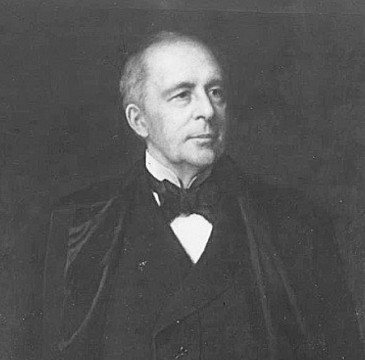Amos Richards Eno (1810-1898)
Merchant & Real Estate Developer, of New York City
He was born at Simsbury, Connecticut. He began his career as a store clerk in Hartford, eventually taking ownership of the store which he sold in 1833 to establish himself as a wholesale dry goods merchant based on Pearl Street in New York City. His success was hot by a set back in 1837 when a fire destroyed his premises and all his stock. He then went into business with his wife's cousin, John J. Phelps, establishing Eno & Phelps that became Eno & Mahoney and then Eno, Roberts, Rhodes & Co. Having made a fortune, he invested his money in Manhattan real estate, picking out "desirable corners, and occasionally he would buy an entire block". When his offices were based at 74 Broadway, he erected the city's first brownstone business premises. He retired from dry goods in 1857 to concentrate solely on his real estate empire.
In 1859, at a cost of $2 million, he built the Fifth Avenue Hotel on an entire city block bound by Fifth Avenue and Madison Square between 23rd Street and 24th Street. Because of its initial distance from the center of town some called it Eno's Folly, but it very quickly became "the social, cultural, political hub of elite New York," while bringing in profits of $250k a year. He leased the hotel to Paran Stevens who had helped to supply some of the capital for its completion and his heirs sold it after his death for $7.25 million. He subsequently built the Madison Square Theatre behind the hotel and founded the Second National Bank that had its main office in the hotel block.
In 1884, it was discovered that his son, John Chester Eno, President of the Second National Bank, had embezzled $4 million and fled to Canada. Mr Eno was heartbroken but personally ensured that every last cent was paid back to his clients out of his own pocket. In his later years, he taught himself Latin, French and Italian, and despite failing eyesight spent his evenings translating Dante, Caesar or Victor Hugo.
For many years he lived at 233 Fifth Avenue, a "broad, four-story, red brick mansion" which he sold in 1890 for $240k to the Reform Club. After the scandal that surrounded his son, he all but retired to his summer home, Simsbury House, but bought in 1897 bought 32 Fifth Avenue (the first example of Second Empire architecture in the States) where he died the following year. He married Lucy, the daughter of Elisha Phelps, U.S. Representative from Connecticut, and they were the parents of seven children. Amos R. Eno left a fortune estimated at $20 million, including $150,000 which he bequeathed to the Chamber of the City of New York to establish a charity fund. His best remembered grandson, Gifford Pinchot, is considered the Father of American Forestry.
In 1859, at a cost of $2 million, he built the Fifth Avenue Hotel on an entire city block bound by Fifth Avenue and Madison Square between 23rd Street and 24th Street. Because of its initial distance from the center of town some called it Eno's Folly, but it very quickly became "the social, cultural, political hub of elite New York," while bringing in profits of $250k a year. He leased the hotel to Paran Stevens who had helped to supply some of the capital for its completion and his heirs sold it after his death for $7.25 million. He subsequently built the Madison Square Theatre behind the hotel and founded the Second National Bank that had its main office in the hotel block.
In 1884, it was discovered that his son, John Chester Eno, President of the Second National Bank, had embezzled $4 million and fled to Canada. Mr Eno was heartbroken but personally ensured that every last cent was paid back to his clients out of his own pocket. In his later years, he taught himself Latin, French and Italian, and despite failing eyesight spent his evenings translating Dante, Caesar or Victor Hugo.
For many years he lived at 233 Fifth Avenue, a "broad, four-story, red brick mansion" which he sold in 1890 for $240k to the Reform Club. After the scandal that surrounded his son, he all but retired to his summer home, Simsbury House, but bought in 1897 bought 32 Fifth Avenue (the first example of Second Empire architecture in the States) where he died the following year. He married Lucy, the daughter of Elisha Phelps, U.S. Representative from Connecticut, and they were the parents of seven children. Amos R. Eno left a fortune estimated at $20 million, including $150,000 which he bequeathed to the Chamber of the City of New York to establish a charity fund. His best remembered grandson, Gifford Pinchot, is considered the Father of American Forestry.







